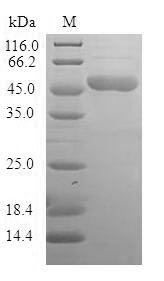The region for expressing recombinant Human BAG2 contains amino acids 1-211. This BAG2 protein is theoretically predicted to have a molecular weight of 50.8 kDa. The BAG2 protein was expressed in e.coli. The N-terminal GST tag was fused into the coding gene segment of BAG2, making it easier to detect and purify the BAG2 recombinant protein in the later stages of expression and purification.
The research of BAG family molecular chaperone regulator 2 (BAG2) covers various scientific areas. In cancer research, the expression of BAG2 is closely associated with the occurrence and development of multiple tumors, particularly playing a crucial role in regulating cell apoptosis, proliferation, and migration. Scientists have discovered that BAG2, through interactions with molecular chaperones, is involved in protein folding and degradation, playing a vital role in intracellular protein quality control. In the field of neurology, the study of BAG2 involves the pathogenic mechanisms of neurodegenerative diseases, as its relationship with protein stability is believed to potentially impact the survival of neurons.






